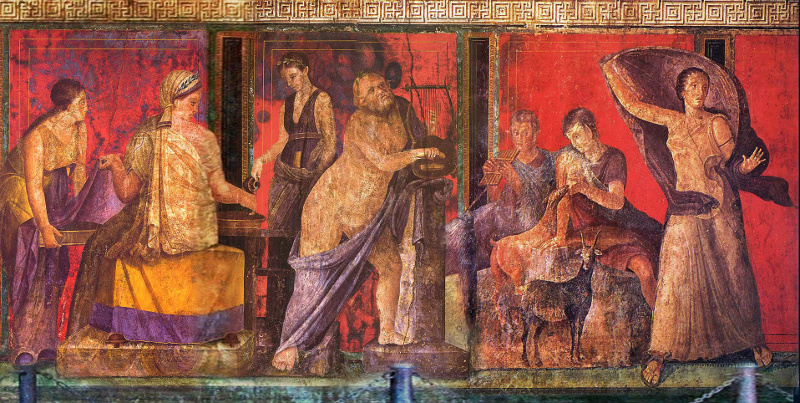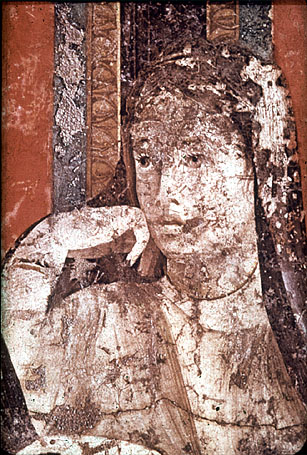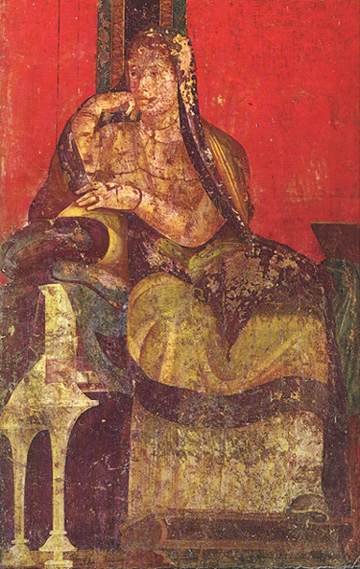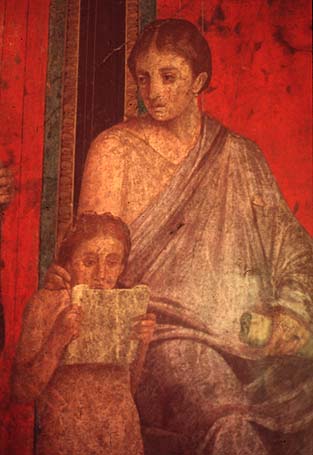When the ruins of Pompeii came to light, they caused a revolution in taste- stripping away rococo gilt, reshaping the female figure, and leaving a deposit of pseudo-Greek temples from Moscow to Mississippi; although what sometimes passed for “classical” would have bewildered the ancients….
Pompeii was frozen in time by the volcanic eruption of Vesuvius in 79 A.D., and not unearthed until 1748. Pompeii was a seaside resort, devoted to the arts, relaxation, and the pursuit of pleasure.The ruins of the ancient cities tragically destroyed by the eruption of Mount Vesuvius in AD 79 continue to excite our imagination just as they did when they were rediscovered in the eighteenth century. The finding of such well-preserved examples of ancient civilization helped spark the Enlightenment and an interest throughout the Western world in ancient art and design, classical philosophy and literature. Much scholarship has been produced which documents the finds at two of the most important sites: Herculaneum, which was first excavated in 1738, and Pompeii, first excavated in 1748.

Part of a remarkable frieze uncovered in 1930 at Pompeii. It depicts the initiation rites of a Dionysiac mystery cult, but in such a way as to make interpretation difficult for the outsider. Thus, when a priestess is shown presiding at the ritual table, her back is turned to us and we cannot see what lies in the basket.
By far the greatest stimulus to the rising fashion for Italian classical taste in the eighteenth century came from Johann Joachim Winckelman. The son of a cobbler and at first destined for that trade himself, he was entranced by the ancient world. The Greeks to him were incapable of error, and he wrote of their statues with a passion that disturbs one by its very intensity. Greek art, Greek artists, and the Greek way of life were the perfect goals toward which one should strive. Nothing did more to stimulate the craze for the classics than Wincklemann’s love affair with antiquity. His famous “Thoughts on the Imitation of Greek Painting and Sculpture” , published in 1755, and his great masterpiece, the “History of Ancient Art” (1764), marked an epoch in the history of art.

Fantin:This people worshipped the idol under the name of Priapus, whom they supposed to be a son of Venus and of Bacchus, and they instituted feasts and mysteries in his honour. From them ultimately the worship was transmitted to the Greeks, as we learn in Herodotus, and from the Greeks it passed on to the Romans. St. Augustine declares that in several towns of Italy, not only was the phallus borne in triumph in public processions, but that obscene songs were sung in its honour; and in fine, that it was solemnly crowned by the gravest of the matrons (St. Augustine, City of God).
The books were in large part, eulogies of all things Greek. He even made the rather dubious point, that the beauty of the Greek language, so rich in vowels, indicates that those who spoke it must have been exceedingly beautiful. However, he spewed out what the public seemed willing to hear, and these two books touched off a forest fire, a wild blaze of neoclassical enthusiasm which torched through Europe out to the edges of civilization. Winckelman said little that was new; but he said it louser, more frequently, and with greater weight than anybody had said it before.

Fantin:Before Christianity had revealed to the world its great civilizing secrets, men rendered a strange worship to those material objects which acted most directly on their senses. It may even be supposed that a very long time before the Christian era there was no other worship than that of symbols. The divinity who presided over the reproduction of the human species, the miracle of all epochs, deserved the purest homage. That vague desire which precedes the union of two lovers, the burning pleasure which marks its accomplishment, the soft languor that follows, all received a name, a soul, an attribute, and Love was hailed as king of heaven by the acclamation of the world: Not safely shall we seem Love's lightest law: He reigns, and holds the highest gods in awe.--Ovid.
He was heard and he was believed. “Let no man,” he commanded, “who has not formed his taste upon antiquity take it into his head to act the connoisseur of beauty: his ideas must be a parcel of whimsies.” Ever ready to be directed, the world of fashion took note and then took action. From now on, to be classical was to be avant-garde.
Excavations became the popular diversion of the day, and excavators equipped with little more than optimism, credulity, and perhaps a spade or two swarmed all over Europe. In this atmosphere the finds at Herculaneum and Pompeii took on a new glamour, and their influence was strengthened when in the middle years of the century Palmyra, Athens, Ionia, and Paestum were opened up.

"View of a terror stricken woman. From the Great Frieze of the Dionysiac Mysteries, in the Villa of the Mysteries, Pompeii. Augustan period; 2nd style."
Perhaps the most important vehicle of expression for the new discoveries was the Grand Tour; the hordes of “milords inglesi&
1; who flocked to the Continent to complete their education provided a wonderful audience for the excavations, and they quickly spread the word through the influential accounts of Horace Walpole and poet Thomas Gray. Italy, the fountainhead of antiquity, became “the” place to visit, to see, to experience- indeed, some, like Lord Pembroke, held it to be the only proper place to learn to make love and recommended his former Italian flame to his son.
Joseph Addison’s “Cato” was but one of a long series of heroic dramas on Roman themes that entertained the theatregoers of eighteenth-century England; and in the seventeenth centuryJean Racine’s “Andromaque”, “I phigénie,” and “Phedre” had simialrly peopled the French stage with figure from Greek mythology. But the new discoveries gave fresh vigor to the classical ideal. To many, the world of Greece and Rome seemed suddenly alive for the first time, and they flocked to Naples to see it: to stand amid the freshly revealed ruins, to marvel at their preservation, and to imagine the cities alive and lived-in.

Detail of the domina, from the Great Frieze of the Dionysiac Mysteries, in the Villa of the Mysteries, Pompeii. Augustan period; 2nd style.
Such experiences heightened the tourists’ desire to possess some relic of this world. Ever since the Renaissance they had collected classical bronzes, medaillons, and marbles as souvenirs of their Tour. Now a whole museum of such objects awaited them, with the added glamour of the dramatic circumstances in which they were found and the voice of Winckelman as a guarantee of their nobility and value. Flattered and delighted to discover that their hobbies had been raised to the status of scientific scholarship , the collectors and connoisseurs bought with renewed fervor, and they were willing to pay handsomely. A stream of objects- real, false and indifferent- was soon flowing across the Continent to fill the studies and decorate their gardens in England. The world of fashion had gone Pompeii-mad.

R.A.S. Seaford:Livy's account of the ritual is an absurd picture of every kind of sexual abuse, murder, even the forgery of wills. But he gives certain details which, because they are not designed to denigrate the cult, may reflect reality. For example, he says that among the leaders of the cult in 186 BC was a Campanian. Campania was the part of Hellenised Southern Italy nearest to Rome, and so we would expect it to be a source of the Greek Mysteries in Rome; and indeed our fresco is just one indication of the continuing strength of the Mysteries in Campania. Livy also says that the cult was originally confined to women, but by 186 BC there were a few men, and a few nobiles of both sexes. Initiation required a certain preparation, consisting of at least a meal and purification. There appear to have been two grades of initiate, the first grade consisting of those who had merely made their prayers from the sacred formula (ex carmine sacro), the priest dictating the words. Another detail which may derive from reality is the youth of those initiated (boys under 20, as Livy explains it, being desired for the purposes of vice and corruption)....
ADDENDUM:
“Pompeii was a seaside resort, devoted to the arts, relaxation, and the pursuit of pleasure. The excavators were horrified to discover erotic frescos, mosaics, statuary and phallic votive objects. The moveable erotic artifacts were taken to Naples and kept in seclusion in the Royal Museum. The erotic wall and floor art had lockable metal boxes constructed over them and were displayed to tourists for an extra fee (women and children excluded). When I visited Pompeii in the late 1960s, this peepshow was still in operation.
This work is a translation of a book by a 19th Century French antiquarian César Famin. In 1816 (according to a citation in the Library of Congress catalog) he published (under the initials M. C. F.) Musée royal de Naples; peintures, bronzes et statues érotiques du cabinet secret, avec leur explication containing sixty lithographs of the best erotic artifacts in the Naples collection. … The French authorities confiscated and destroyed most known copies of the original book.

Fantin:Nothing is more curious to observe than the veneration of certain modern populations for these ornaments considered as talismans. In Italy, when a man happens to have neglected to take with him one of these singular amulets, it is not unusual to see him place his hand affectedly on his genital parts, at the sight of any person whose untoward features awaken suspicions of evil hap. Further than this we have ourselves many times seen credulous men in Sicily, and women too, testify the greatest possible respect to a priest or monk, by lightly touching his virile parts with the tip of their fingers, and afterwards devoutly kissing their own hands. In Spain it is the same; and among the Mahometans pregnant women hold it as a great consolation to be able to kiss the sexual parts of a madman. In the East the worship of the phallus has been perpetuated with still greater unreserve; and the lingam or pulleiar worshipped amongst the Indians, is, as is well known, a symbol of the union of the two sexes....
In 1871, an English translation of Famin’s work was published in England under the byline of ‘Colonel Fanin’. Privately printed in a limited edition, this translation became one of the rarest erotic books. A photographic reprint of this was published in 1969 in paperback by ‘Collectors Publications’ (City of Industry, CA), under the title The Secret Erotic Paintings. Collectors Publications was a fly-by-night pulp publisher whose line consisted mostly of stroke books, ‘marriage’ manuals, pirate editions of Grove Press books, and a few reprints of rare erotic books. The 1969 paperback edition, with atrocious color separations, was the source of this etext and the accompanying images. Originally priced at $15 (an astronomical price for a poorly printed 150 page paperback at the time–a more typical price was 50 cents), used copies of this run up to $50 on the Internet.
Famin’s text to accompany the images is deeply conflicted. He is obviously drawn to the subject matter and has a deep understanding of the significance of the artifacts. He also takes every opportunity to condemn Classical sexual practices and cultural values. Whether this is a figleaf or a sincere reaction is impossible to determine. However, in spite of the ‘shocked, shocked’ attitude in Famin’s text, it contains quite a bit of valid and well-researched information, including quotes from classical authors and details of mythology, artistic methods, spiritual practices, architecture, and literature.
Famin:It remains for us to add that superstition, born of the excesses of a burning imagination in southern climates, attributed extraordinary virtues to the priapic sign. Women who were barren suspended little phalluses in bronze or stone to their necks; men followed by maleficent genii also carried it about them to keep off sorceries; pilgrimages were performed to the temples of Priapus; the knee was bent in worship before the phallus; at a certain period of the year the virginity of a young girl was sacrificed to the god. On these occasions the victim was placed on the virile attribute of the statue of the god, and there remained during the entire accomplishment of this shameful and cruel homage. “The newly married woman was wont to be placed on the upright instrument, which was fixed in her privy parts, in order that the god might seem to have the first outpouring of her virginity” (Lactantius).
…At last Christianity came and sapped the foundations of this abominable worship. The idols were overturned; but men kept the recollection of them at the bottom of their hearts; and, with pain it must be said that, while, varying the forms of these impure rites, they have perpetuated the usage of them. Thus in Italy, where superstition has struck deep roots, the attribute of virility is considered a sure safeguard against evil spirits. In Naples especially, and in Sicily, every one carries about them (women on their bosoms, and men on their watch-chains) little horns of coral, lava, ivory, &c. Some of immense size may be seen in the antechambers of persons one would never have suspected of such a weakness, and no one blushes to admit that they are talismans against witchcraft. Modesty has substituted these for the phallus of the ancients, to which also were attributed preservative virtues against witchcraft. Indeed we may see several of these obscene presentations furnished with a quantity of little bells; it cannot therefore be doubted that these objects were used as amulets, seeing that bells were consecrated to Priapus, who was also called The Noisy (Βριήπυος). Theocritus said that the noise of bronze chased away impurities (ἀπελασικὸν τῶν μιασμάτων). May it not be a traditional remnant of this superstition that makes the country people believe that the noise of the bells keeps away storms?







 COMMENTS
COMMENTS



